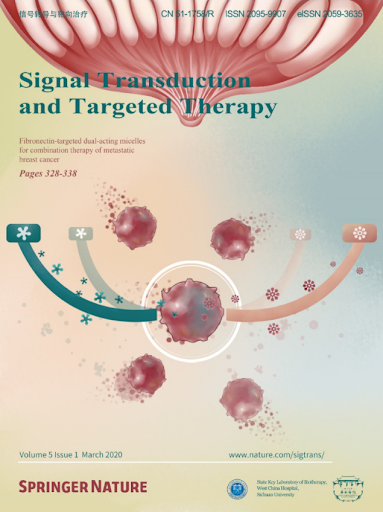化疗、舒法替尼(一种血管免疫激酶抑制剂)和camrelizumab(一种抗pd -1抗体)一线治疗局部晚期或转移性胰腺导管腺癌:一项Ib/II期随机研究。
IF 52.7
1区 医学
Q1 BIOCHEMISTRY & MOLECULAR BIOLOGY
引用次数: 0
摘要
胰腺导管腺癌(PDAC)预后差,一线治疗有限。这项Ib/II期随机试验(NCT05218889)研究了舒法替尼联合camrelizumab和nab-紫杉醇/S-1 (NASCA)与nab-紫杉醇和吉西他滨在局部晚期或转移性PDAC患者中的疗效和安全性。主要终点是Ib期剂量限制性毒性和推荐II期剂量(RP2D),以及II期客观缓解率(ORR)。Ib期采用3 + 3剂量递增设计来确定6例患者的舒法替尼RP2D,确定为200mg。在II期,患者按1:1的比例随机分配,接受NASCA(45例)或nab-紫杉醇和吉西他滨(45例)。NASCA组的ORR为51.1%(23/45),而nab-紫杉醇和吉西他滨组的ORR为24.4%(11/45)(优势比3.2,95% CI 1.3-8.2, p = 0.01)。中位无进展生存期(PFS)为7.9个月对5.3个月(HR 0.63, 95% CI 0.40-0.99, p = 0.045)。中位总生存期为13.0个月对11.0个月(HR 0.77, 95% CI 0.47-1.28, p = 0.318)。最常见的≥3级治疗相关不良事件是中性粒细胞计数减少(33.3%对35.6%)。在NASCA组中,与没有这些特征的患者相比,CD8+和CD8+PD-1+细胞的富集,M1/M2巨噬细胞的高基线比率以及CA19-9水平的降低在第6周和第12周与PFS的改善相关。相对于nab-紫杉醇和吉西他滨,NASCA方案对局部晚期或转移性PDAC显示出有希望的疗效和可耐受的安全性。本文章由计算机程序翻译,如有差异,请以英文原文为准。
First-line treatment with chemotherapy, surufatinib (an angio-immuno kinase inhibitor), and camrelizumab (an anti-PD-1 antibody) for locally advanced or metastatic pancreatic ductal adenocarcinoma: a phase Ib/II randomized study.
Pancreatic ductal adenocarcinoma (PDAC) has a poor prognosis and limited first-line treatments. This phase Ib/II randomized trial (NCT05218889) investigated the efficacy and safety of surufatinib plus camrelizumab and nab-paclitaxel/S-1 (NASCA) versus nab-paclitaxel and gemcitabine in patients with locally advanced or metastatic PDAC. The primary endpoints were dose-limiting toxicities and the recommended phase II dose (RP2D) of surufatinib in phase Ib, and the objective response rate (ORR) in phase II. Phase Ib used a 3 + 3 dose-escalation design to determine the RP2D of surufatinib in six patients, which was established at 200 mg. In phase II, patients were randomized 1:1 to receive the NASCA (45 patients) or nab-paclitaxel and gemcitabine (45 patients). NASCA group showed an ORR of 51.1% (23/45) versus 24.4% (11/45) in the nab-paclitaxel and gemcitabine group (odds ratio 3.2, 95% CI 1.3-8.2, p = 0.01). The median progression-free survival (PFS) was 7.9 vs. 5.3 months (HR 0.63, 95% CI 0.40-0.99, p = 0.045). The median overall survival was 13.0 vs. 11.0 months (HR 0.77, 95% CI 0.47-1.28, p = 0.318). The most common Grade ≥3 treatment-related adverse event was decreased neutrophil count (33.3% vs. 35.6%). In the NASCA group, enrichment of CD8+ and CD8+PD-1+ cells, a high baseline M1/M2 macrophage ratio, and a reduction in CA19-9 levels at weeks 6 and 12 were associated with improved PFS compared to patients without these features. The NASCA regimen showed promising efficacy with tolerable safety relative to nab-paclitaxel and gemcitabine for locally advanced or metastatic PDAC.
求助全文
通过发布文献求助,成功后即可免费获取论文全文。
去求助
来源期刊

Signal Transduction and Targeted Therapy
Biochemistry, Genetics and Molecular Biology-Genetics
CiteScore
44.50
自引率
1.50%
发文量
384
审稿时长
5 weeks
期刊介绍:
Signal Transduction and Targeted Therapy is an open access journal that focuses on timely publication of cutting-edge discoveries and advancements in basic science and clinical research related to signal transduction and targeted therapy.
Scope: The journal covers research on major human diseases, including, but not limited to:
Cancer,Cardiovascular diseases,Autoimmune diseases,Nervous system diseases.
 求助内容:
求助内容: 应助结果提醒方式:
应助结果提醒方式:


